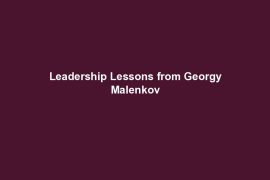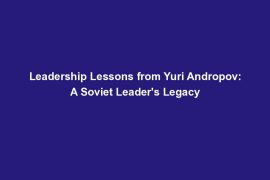Have you ever heard of Alexander Kerensky? No? Well, you’re in for a treat because today we’re diving into the world of this fascinating historical figure and uncovering some valuable leadership lessons that we can all learn from.
So, who exactly was Alexander Kerensky? He was a key player in the Russian Revolution of 1917, serving as the head of the Provisional Government. Despite facing immense political challenges, Kerensky embraced democratic principles and worked tirelessly to navigate the tumultuous waters of Russian politics.
But why should we care about learning from Kerensky’s leadership style? Well, his experiences offer us a unique opportunity to glean insights into effective leadership strategies, especially in times of crisis and change. By studying his approach to building consensus, communicating effectively, and inspiring trust, we can gain valuable lessons that are still relevant in today’s world.
In this blog post, we’ll take a closer look at the key leadership lessons that can be learned from Alexander Kerensky’s experiences. From embracing democratic principles to building consensus and communication effectively, there’s plenty to uncover. So, let’s dive in and explore how we can apply Kerensky’s leadership lessons to our own lives, shall we?
Embracing Democratic Principles While Navigating Political Challenges
One of the key leadership lessons we can learn from Alexander Kerensky is the importance of embracing democratic principles even in the face of political challenges. Kerensky believed in the power of democracy to bring about positive change, and he worked tirelessly to promote transparency, accountability, and fairness in the government.
However, Kerensky also faced numerous political challenges during his time in power. From dealing with opposition groups to navigating complex political alliances, he had to find a way to stay true to his democratic principles while also taking pragmatic steps to ensure stability and progress.
Building Consensus and Collaboration Within a Diverse Group of Stakeholders
Another crucial leadership lesson from Kerensky is the ability to build consensus and collaboration within a diverse group of stakeholders. As a leader, Kerensky had to work with people from different backgrounds, ideologies, and interests in order to move his agenda forward.
By fostering open communication, listening to various viewpoints, and finding common ground among conflicting parties, Kerensky was able to build a coalition of support for his initiatives. This not only helped him secure the necessary backing for his policies but also created a sense of unity and cohesion among his team.
Communicating Effectively with the Public and Inspiring Trust and Confidence
Lastly, Alexander Kerensky understood the importance of effective communication in inspiring trust and confidence among the public. Whether addressing a crowd, giving a press conference, or writing a statement, Kerensky knew how to convey his message with clarity, passion, and conviction.
By being transparent, honest, and empathetic in his communication, Kerensky was able to connect with the masses and gain their trust. This not only made him a more effective leader but also helped him rally public support for his vision and policies.
In summary, the leadership lessons from Alexander Kerensky are timeless and can be applied in various leadership contexts. By embracing democratic principles, building consensus, and communicating effectively, leaders can navigate challenges, foster collaboration, and inspire confidence in their followers. Next, we will explore how modern leaders have successfully applied Kerensky’s principles and provide practical tips for implementing these lessons in your own leadership style. Stay tuned for more insightful information in the upcoming sections!
Applying Kerensky’s Leadership Lessons Today
Now that we’ve delved into the leadership lessons we can learn from Alexander Kerensky, let’s explore how these principles can be applied in today’s world. By examining case studies of modern leaders who have successfully embraced Kerensky’s approach, we can gain a better understanding of how effective leadership can shape the course of history.
Case Studies of Modern Leaders
One shining example of a modern leader who embodies Kerensky’s principles is Jacinda Ardern, the Prime Minister of New Zealand. Ardern is known for her ability to effectively communicate with the public, build consensus among diverse stakeholders, and inspire trust and confidence in her leadership. By following in Kerensky’s footsteps, Ardern has been able to navigate political challenges and unite her country in times of crisis.
Another leader who has drawn inspiration from Kerensky is Justin Trudeau, the Prime Minister of Canada. Trudeau’s emphasis on democratic principles, collaboration, and effective communication mirrors the leadership style of Kerensky. By fostering an inclusive and transparent government, Trudeau has garnered support from a wide range of constituents and built a strong foundation for sustainable leadership.
Practical Tips for Implementation
For those looking to incorporate Kerensky’s leadership lessons into their own style, there are several practical tips to consider. First and foremost, prioritize open communication and transparency within your organization. By fostering a culture of trust and collaboration, you can build a strong foundation for effective leadership. Additionally, seek consensus among diverse stakeholders and make an effort to understand and address their concerns. By embracing democratic principles and valuing the input of others, you can create a sense of unity and purpose within your team.
Conclusion: Timeless Relevance
In conclusion, Alexander Kerensky’s leadership philosophy offers valuable insights that are still relevant in today’s world. By embracing democratic principles, building consensus, and communicating effectively, leaders can inspire trust and confidence in their abilities. The timeless relevance of Kerensky’s approach underscores the importance of thoughtful and inclusive leadership in shaping a better future for all.



